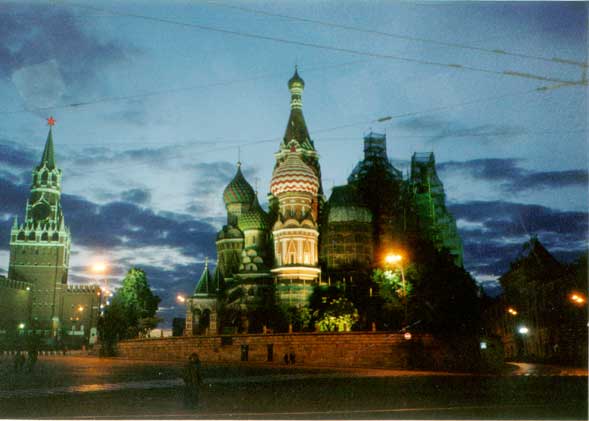

While Moscow is 11 time zones different than LA, the architecture and living environment seemed 11 centuries different. We did not see a single "private family" home -- although we drove by the new "townhouses" of a few attached two story dwellings. We saw restaurants and coffee shops everywhere, food, cut flowers and fresh fruit kiosks on the street, shops and stores full of merchandise, and widespread signs of an entrepreneurial spirit. Truly incredible sights given that we were told that none of this existed 11 years ago. We marveled at the elegance and grace of the Byzantine "onion" domes of the Russian Orthodox churches, and were blown away by the stories of the history of this vast country. But the bureaucracy and distrust continue to be part of daily life.
Our Russian experience began long before we set foot in that part of the world. With some Internet and travel book research we decided to seek out a tour guide to support our getting around. We wrote to several companies and one in particular, EscapeTravel, responded most favorably. We had them assist with a guide and driver when needed, and travel arrangements between cities. This turned out to be an outstanding move, paying us real dividends in terms of time and hassle.
To get our visas, we needed to provide details on arrival and departure dates with proof of airline tickets, as well as detailed itinerary with proof of hotel stays, all verifiable by an approved travel agency. It took several tries of submitting our material to the Russian Embassy in Washington, DC, and EscapeTravel providing all the official materials.
But Moscow was full surprises, making the bureaucracy tolerable. Red Square is a long rectangle with the Kremlin wall running the length on one side, and Gum Department Store running the length on the other side. Saint Basil's Church, with its striking onion domes is at one end, and the gothic architecture of the Natural History Museum at the other. The picture below shows Red Square during the day while the picture at the start of our story was taken about 11:00 PM at night
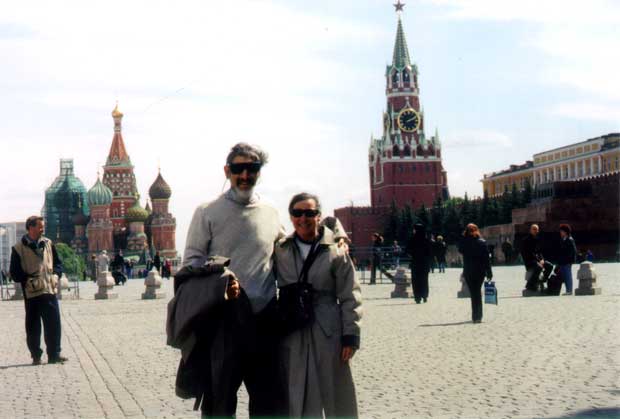
In the Kremlin (the Russian word for fortress), all but one of the buildings was built between the 15th and 17th century. The one exception was a building built in 1959 made of glass and steel called the Palace of Congress. Our guide, who had worked for the government Intourist guide service before 1991, told us that when he worked for the government he was instructed to say that all the buildings in the Kremlin blended in so nicely, including the Palace of Congress. He said he felt stupid saying that knowing it was a lie and no tourist would ever believe him. The reality is that it's a real eye sore in that environment and stands out like a sore thumb!
Another Moscow surprise was the metro -- not the trains but the stations. Construction began in the 1930s. The stations were to be palaces for the people, built of granite, marble, with tiles and various other stones, used along with fancy chandeliers, like the one shown below. We visited about a dozen stations, just to see the art and architecture. Each station had a theme expressed through art work, fresco, mosaics, and sculpture which adorned the walls and main thoroughfares.

In stark contrast to the beauty of the physical space was the ugliness of the way in which the space was manipulated to control the people. We were surprised that in the middle of a workday, the subways were mobbed. The trains ran very frequently (within minutes) and we were told that they were always crowded. Most of the stations were very deep (built with the thought that they would serve as bomb shelters, which they did). Very long escalators led down to the train platforms. For most of the stations we visited, there were four escalators side-by-side, but only two were turned on. Our guide told us that was always the situation. It was not that they weren't in working condition, nor that they were trying to save electricity, it was just a way to make it inconvenient for the people. And, when we went to exit, it was always the case that only one of four or five or six doors would be unlocked. The hordes of people all were forced to go through the single door. No handicapped ramps or facilities exist as the people were told that "in Russia everyone was perfect."
One of the most interesting episodes was our visit to the Library of Science and Technology. Jason had been given the name of the director of the library by a colleague, so we looked up the library and went to visit. The front of the building was in disrepair, and of course, only one of the three doors leading into the building was unlocked. Inside the door there was a security guard. He was checking ID and having people sign-in. We showed our paper (written in English of course) and he pointed and gestured, but our letter was as Greek to him as his Cyrillic was Greek to us. So we started asking everyone coming and going if they spoke any English. And, after a while a lady said "a little" and as it turned out, she was the secretary of the person whose name we had. She told us to wait and she'd be back for us. She disappeared for over a half hour, returning with two officially stamped and signed forms that allowed the security guard to let us pass. The director's secretary then took us for a wonderful tour. The library users could not circulate among the books nor could they check them out. They needed to use the card catalogue to find what they wanted, fill out a form, and have library staff get it for them to use in a reading room. The copy room was very busy as that was the way individuals could take home the pages they were most interested in. In the journal room, our guide showed us the couple of journals in English. Most were in Russian. We were told there were over 700 employees working in the library, doing everything from traditional cataloguing, public service functions, to all the computer support functions (they are computerizing their catalogue), and administration.
We visited two major museums in Moscow: the armory inside the Kremlin and the Puskin. At the Armory, we saw the crown jewels, clothes of the czars and czarinas, and the carriage room which held the vehicles designed to carry royalty in splendor. And of course, we saw the Faberge Eggs. Each egg had a surprise inside, like a train on a track or a clock or model palace.
The Puskin Museum was fascinating. During the 1930s, to enable Russian art students to see the great sculptures from around the world, Russian artists went to all the great museums and made plaster replicas. We certainly could not tell that Michealago's David was a copy!
In addition to the museums, we visited a dozen Russian Orthodox churches. The onion domes from "inside" were frequently as impressive as from the outside. Every inch of the interior was covered with pictures. There were no statues, but rather Icons (religious paintings) covered the walls, ceilings, and pillars. Each church had an Icon Tier displaying four layers of saints (local saints at the bottom and biblical saints at the top).
We also visited the Moscow Choral Synagogue which opened in 1891. The exterior and interior architecture was magnificent.
Across the street from the Synagogue was a beautiful sculpture

In contrast to Moscow (the core of which is a 15th century Byzantine fortress) is Saint Petersburg (the core of which is 18th century European splendid palaces). The city was designed and built by Czar Peter the Great in 1703. The 299th anniversary was celebrated on May 27th during our stay (meaning the crowds were worse than ever). To put it bluntly, Saint Petersburg is an opulent European treasure trove. Palaces and elaborate mansions coexist with waterways and canals, making this one of the most beautiful cities which we have visited in all of Europe. In fact, we saw so many columns adorning buildings and churches, we think Saint Petersburg should be called "Saint Palaceburg." It made it clearer why a revolution leading to socialism could occur in this part of the world. Along those lines, it was extremely impressive that the 1917 revolutionaries nationalized and preserved the wealth of the church and nobility rather than plunder it (as their 1789 French counterparts did). They converted everything to museums.
In Saint Petersburg, we were shocked to find that the Louvre, one of the worlds greatest museums, actually has a rival in the Hermitage (which claims to have the largest museum collection in the world). The extravagance and majesty of this complex set of six buildings was astounding. The picture below was taken outside the entrance to the Hermitage

The décor of the rooms themselves are works of art. Each room has a level of grace and beauty easily challenging the beauty of the art which it contains. Click here if you wish to see more details of the interiors of the rooms at the Hermitage Web site.
The art collection of the Hermitage easily rivals that of the Louvre. While not having some of the super famous pieces of art (such as the Mona Lisa), the Hermitage had its own stellar works by Leoardo de Vinci, as well as the largest collection of French art outside France, displaying works by Degas, Renoir, Cézanne, Monet, and others. Click here for The State Hermitage Museum: Collection Highlights
Peterhof was the summer palace constructed by Peter the Great. He had been impressed by the fountains and gardens of Versailles and decided to outdo them. He had splendid fountains constructed, all of which run from natural water pressure obtained from springs over ten miles away. We were fortunate to be at Peterhof on the day they turned the fountains on for the summer. The crowd was huge, all being controlled by army, navy, and airforce military personnel. They lined the path ways to form a human fence so that the visitors stayed off the lawns. There were fireworks and speeches (we couldn't understand the words, but sure knew what the message was: vote for me! Seems the politicians don't miss a chance no matter where in the world they are!!!) The picture below along an isolated path shows the wonderful flowers and a grand fountain.
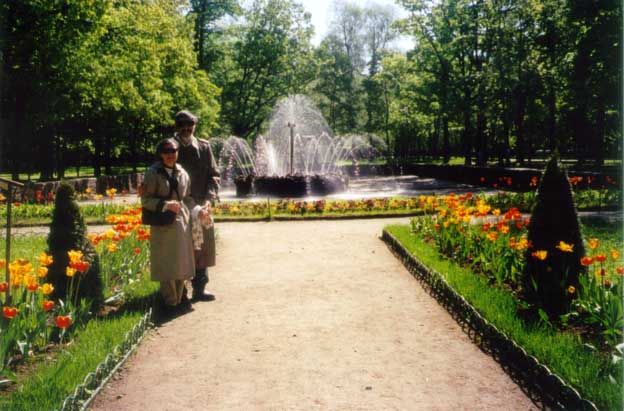
Another incredible structure was Catherine Palace. Its elegant façade is shown below and greater detail can be found at the Palace website.
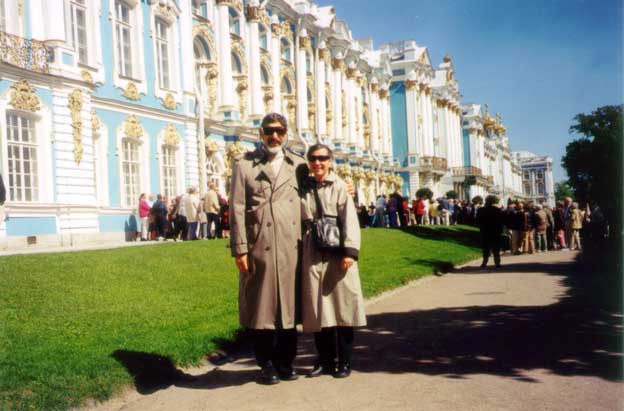
This palace was occupied by the Nazis during the war and mostly destroyed. There has been a major restoration effort over the past fifty years to recreate the splendor of this 18th century palace. Almost all the art had been sent to Siberia during the war so it was preserved. (This was true for the art from the Hermitage, Peterhoff, and many other palaces and museum throughout Saint Petersburg and Moscow.) The garden at Catherine's Palace was of the English formal garden variety, including man made ponds and canals. The far end of the Palace had a stair case that made you feel as if you were at the steps of a Roman villa.
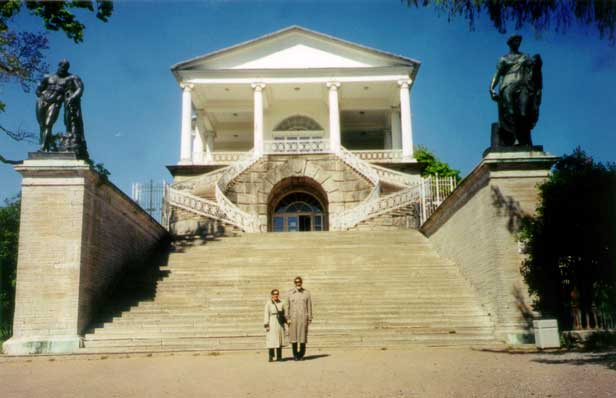
Another building we visited which is undergoing restoration was the Saint Petersburg Choral Synagogue. Restoration of the Synagogue started in 1998. The architecture is in a Moorish style with the archway flanked by elegant minarets.
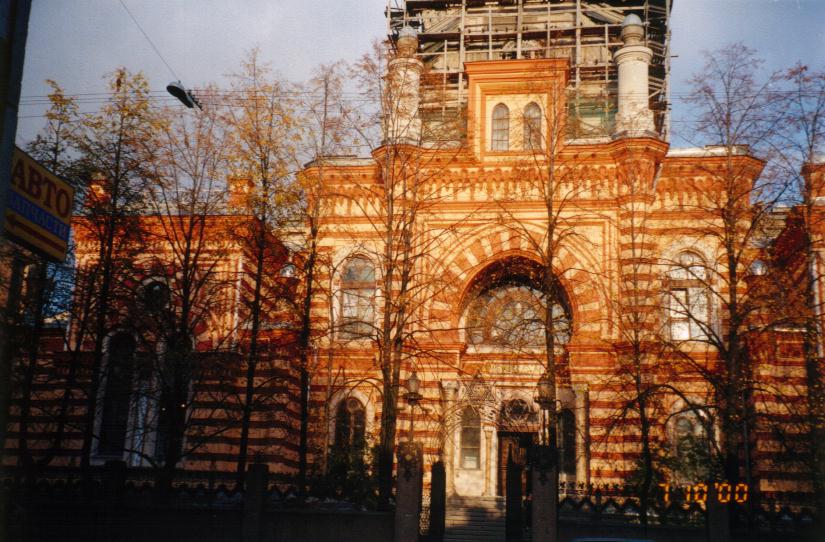
The interior decor was equally beautiful.
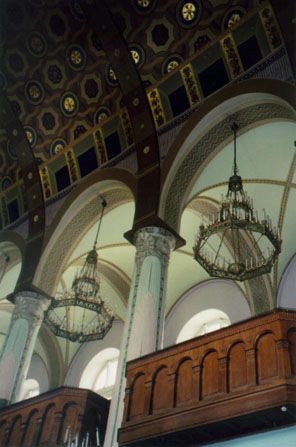
We also visited The Yussupov Palace. Among the art and within the guilded private theater, we heard the story of Rasputin, the "evil" advisor to the last Czarina, and of his murder by her nephew. This is such a stirring story, that they actually had life size mannequins arranged so we could see the action unfold. One night in December 1916, Rasputin was invited by Prince Felix Felixovich Yussupov to visit his palace on the pretext to meet his wife. Felix had a secret room, reached by a tiny hexagonal hall (with six doors, four of which were fake). It was fascinating see this hall. In the secret room, Rasputin was poisoned, shot several times, beaten, and when he refused to die, finally thrown into a frozen river before he finally succumbed.
We asked everyone we could speak with about the changes which occurred with Glasnost and Parastrokia. As one person said, "Glasnost enabled us to hear more of the truth and to criticize the government. For the first time, people could think for themselves." He told us that Russian history books said that the Russian army conquered Napoleon in the siege of Moscow in 1814. He was shocked to learn the truth that the two armies never fought, but the French froze to death in the Russian winter.
Parastrokia brought about changes in the economic structure, opening opportunities for privatization and entreprenurship. Many individuals went to work for themselves and the kiosks and small businesses we saw everywhere were a result. We heard people saying that they now had the opportunity to make something of themselves as we saw in the emerging restaurant and hotel businesses. One of the waitresses at our hotel aggressively sought the opportunity to speak English and spent almost our entire meal with us. She was going to business school and was pursuing a career in hotel management. You could see in the way she carried herself and communicated that she was going to be successful.
Our driver in Saint Petersburg said the opportunity was there for those who wanted it. Before 1991 he was a researcher (has his doctorate in physics), but with the fall the Communist party, his unit was closed. Now he earns $100 per moth as a university professor. He also works as a tour driver (or as the guide for Italian and German groups) as he makes more money that way than teaching.
With the changes and moves toward capitalism, most of the people we spoke with complained that things are very rough and the times are very hard. Pensions are smaller, apartments were privatized and most people could not afford to purchase them. When asked if they would want to return to the earlier system, everyone said either "no" or "that's a difficult question." Corruption in government was considered the norm. As one person said "When the breakup occurred, who ever was closest to the bowl of soup grabbed the ladle."
Even with the changes, the bureaucracy and inefficiency was overwhelming. Unnecessary paper work seemed to be the rule. At Peterhof, we went with our guide who had to exchange our admission certificate for tickets. We stood there and watched the clerk hand copy all the information off the certificate onto another form. She did this twice since they didn't use carbon paper. When we asked our guide what she was going to do with the paper work, she replied "probably throw it in the trash." This same procedure occurred at each museum.
Our tour guides had all worked for the government (KBG?) Intourist guide service before 1991. They told us that during that period they had to report questions tourists asked, or if the tourist requested to see friends or relatives, they were to report the names and phone numbers. They were also to hand-in and report all gifts and tips. But we must say that if our guides were typical, then the Intourist organization did one heck of a job screening their employees. Guides completed a five year university program. They were walking encyclopedias, able to discuss religion, politics, art, history, and world events. They were multi-lingual, well traveled, and exceptionally pleasant people to be with.
Food on this trip was a mixed bag. In Moscow we ate most of our meals in Russian cafes which seemed to be frequented mainly by locals. We ate lots of borsch (vegetables soup). The beef stroganoff was quite good. In Saint Petersburg, our tour package put us in much higher quality restaurants (a couple we thought were equivalent to a Michelin one or two star). We also had some outstanding European style cuisine, but with a Russian twist.
We attended three ballet performances while in Russia: in Moscow we saw Spartacus at the Bolshoi. In Saint Petersburg, we saw La Bayadere at the Mariinsky and a medley of excerpts from Swan Lake, Giselle, etc. at the Hermitage Theatre. We were disappointed at the overall quality the ballet troupes. One of our tour books indicated that that the top dancers have gone to the west for more money.
In Saint Petersburg, right in the center of town we observed people hitch hiking (they just put out their arm -- both men and women -- and cars stopped to pick them up) and horse back riding (two nights in a row we had to step back on the sidewalk to make way for riders). What a shock! In contrast, we don't remember seeing a single bicycle rider in Russia. But, in both cities we saw numerous McDonalds and KFC. When we came out of the Kremlin, there was a huge Sabarros.

Note that this picture was taken about 11 PM.
Aarhus calls itself "...the smallest big city in the world" since it has so much going on culturally. It had a real small town atmosphere like so many other college towns we've visited. When we walked at night, the streets were totally deserted, except around the pubs and coffee houses, which all seemed to be busy. We enjoyed sitting outside sipping our cappuccino and watching people going by on their bicycles (it reminded us of UC Davis).
Besides the university, Aarhus has an Old Town with many buildings from an earlier time gathered from all around Denmark to make a living museum. But, for us, best of all was the Danish beach woods. We spent our first day in Aarhus going to a Danish beach forest area, walking the trails and enjoying the arboretum. We stumbled upon a duck pond which we greatly enjoyed, hiding under a tree while it rained a bit.

The conference dinner our last night was at the Varna Palace, situated right in the middle of a beach wood area where we had gone walking. The picture from their Web site is below, which shows the beauty of the woods and North Sea.

As it turned out, there was a hotel just "down the path" from the Palace, also overlooking the sea, so we relocated to that much more elegant setting from our noisy hotel in the center of town. This enabled Lois to walk the forest beach paths while Jason conducted his seminar at the university.
We were told we'd stand out in Russia because of the way we walked and dressed. But we fit right in with our overcoats and turtle necks. (The temperature in Russia never got to the 50s.) However, in Denmark, we really stood out. Everyone stared at us like we were from another planet. The temperature had warmed to the fifties, so while we were wearing our overcoats, the Danes were in shorts and tank tops!
On our last night at the conference dinner one of the participants said "Why are you flying back to Copenhagen? The trains are better and faster!" She was right. From the train station in central Aarhus to the train station in downtown Copenhagen was three hours, substantially longer than our 25 minute flight. BUT, since we had to take a one hour bus ride and get to the airport one hour before the flight and then take a 20 minute train from the Copenhagen airport to the downtown train station (after waiting to retrieve our luggage), the train was faster! So, we switched to the train.
We spent our last day in Aarhus once again walking the woods. We took a 6:00 PM train to Copenhagen, had a late dinner at our hotel, (overlooking a canal) and then left at 6:00 AM the following morning to begin our journey home.
